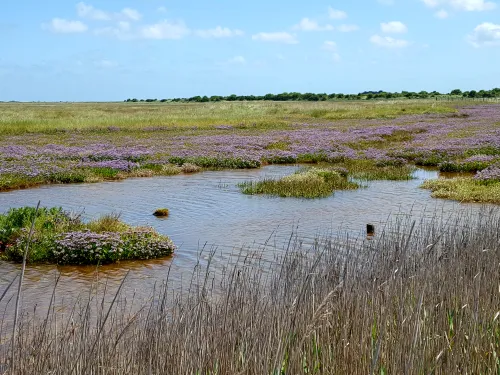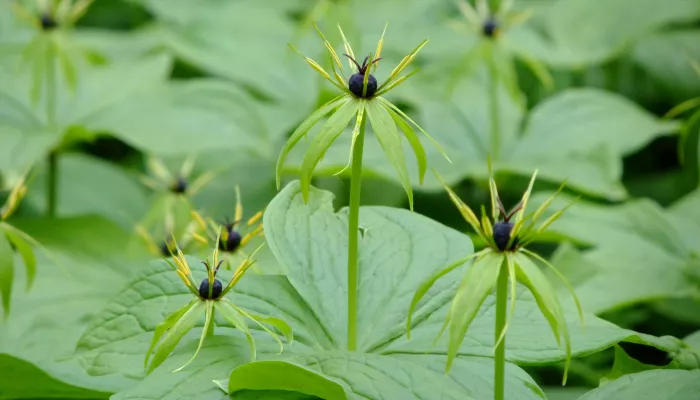
What my Kent Wildlife Trust membership means to me
Teacher, campaigner, and member Kerry Sabin-Dawson talks all about her membership journey in this blog.

My name is Jenny Luddington. I joined the Kent Wildlife Trust 2 years ago, working as a community organiser on the Nextdoor Nature project, which supports communities in Dover to take action for nature, designing and delivering micro projects to help nature and communities thrive.
In February I changed roles and am now the Blue Mentor (Youth Engagement and Education Officer) working with on the Blue Influencer Scheme - an ambitious project to help young people aged 10-14 to deliver youth led social action projects in Folkestone & Dover.
April has been a busy time for me, not just because I’m busy with the Blue Influencer scheme, but because April is also FND Awareness Month and I am living with FND.
So what is FND? FND is an acronym for Functional Neurological Disorder. FND Hope UK, a patient-led charity for people with Functional Neurological Disorder, describes FND as:
'A problem with the functioning of the nervous system and how the brain and body send and receive signals. Physical and/or psychological risk factors can cause functional symptoms which include a variety of physical, sensory and cognitive symptoms that have yet to be explained by a recognised disease. Functional Neurological Disorders are considered to be multifactorial, which means many different risk factors can contribute to the development of the disorder. The symptoms are real and can cause impairment in quality of life that is similar to and in some aspects worse than other neurological conditions. FND occupies a grey area between psychiatry and neurology that historically has failed to gain the interest of researchers and clinicians.'
FND is classified as a rare disease, however, approximately 1/3 of all neurological outpatient appointments are reporting functional symptoms. FND has gained the moniker of the “Most common rare disease that you’ve never heard of”.
I live with epilepsy and FND. I was diagnosed with epilepsy when I was 17, gained seizure control when I was 25, I went on to spend another 12 years seizure free, and 10 of those years I was off medication.
In 2012 I had a break-through seizure (the name given to a seizure after a period of seizure control). I was back on a medication merry-go round as the older medications that I had used to control my seizures but are now linked to birth defects. I was put on several newer anti-convulsant medications, including one that led to me experiencing a psychosis-like episode.
However, there were some differences in how my seizures were presenting, I had previously had mixed seizures, including tonic clonic (the type of seizure that is most commonly associated with epilepsy, where you fall to the floor and start shaking), I also had simple partial seizures (brief absences, which might be mistaken for day dreaming) and complex partial seizures (that for me look like I am trying to rest my arm on an imaginary shelf). My “aura” (the feeling people sometimes have before a seizure) used to be the smell of oranges, was now was a physical sensation, in my stomach, like you might feel after receiving bad news.
After the break-through seizure I started developing twitches, this are often referred to as myoclonic seizures or jerks. This had never been a part of my seizure presentation and I was Googling my symptoms (often a poor choice and I was terrifying myself reading about degenerative brain diseases while waiting to be re-referred to neurology).
I gained a new diagnosed of Juvenile Myoclonic Epilepsy, (I was 37 at the time and wondered how on earth I could have “juvenile” anything). I was not responding well to medications, so in 2016 I was sent for 5 days of video telemetry, weaned off all medications in a hospital setting and the telemetry confirmed that not all my seizures were epileptic and I was given a diagnosis of FND.
At this appointment I was handed a Post-It note for a website address hastily scribbled on it. Pretty much sent on my way. When I had been diagnosed with epilepsy as a teenager there had been a whole raft of leaflets, referral to the specialist epilepsy team, in contrast with an FND diagnosis I was given a referral to neuropsychiatry (which would be a 2 year wait).
As well as seizures, I was experiencing chronic pain and chronic fatigue, however, because I was waiting for neuropsychiatry referral, I couldn’t access pain clinic.
Looking for answers I came across the FND Hope UK Facebook page and found that the Post It note diagnosis was common, currently there is no national clinical pathway so often people are diagnosed and left with little treatment or support.
My symptoms impacted my life in many ways, I was no longer able to work full time and had to give up my full time job. It became unsafe for me to travel independently. It felt like my world had shrunk to the size of a walnut.
Because I need to work part-time I’ve often only been able to work entry level jobs, on minimum wage, that really don’t match my knowledge and experience, like many people I fell down the disability pay gap.
After my FND diagnosis I was removed from frontline work as my employer felt that I was too much of a liability.
In 2021 I wanted to go and study for an MA in Arts, Health and Performance, unfortunately in December 2021 I caught COVID and had some other health issues that meant I had an FND flare, however, my time at university was really beneficial. I learned about social prescribing and via the FND Hope UK Facebook page. I learned about opportunities for seated yoga, Pilates, dance and arts classes, which were really beneficial and helped me with my recovery. I’ve connected with a wonderful group of people and found a sense of community and belonging.
When I recovered from my flare I wanted to find some part-time work again and applied for a the position of Community Organising Assistant and I like to think sharing my lived experience has added value to Kent Wildlife Trust. As someone who has barriers to accessing nature I’ve been able to connect Kent Wildlife Trust to organisations such as Wild With Wheels and Access, Arts and Adventures, who share their expertise about disability inclusion. These organisations offer amazing experiences in nature and opportunities for connection, which when living with chronic illness is a real life line. We’ve also been able to share with this organisations opportunities to learn about the red billed chough reintroduction.
Kent Wildlife trust is committed to working for inclusion for all and I am proud to be part of Equality, Diversity, Inclusivity, and Belonging (EDIB) team working on delivering our strategy. The EDIB now host a “Living Library” where staff and guest speakers can be checked out as a human book, giving lunchtime webinars about the issues that affect them. I co-chair for the Wildlife Trusts disability staff group, Nature For All and have contributed to blog posts about disability inclusion.
During FND Awareness Month people across the globe work to raise awareness, through activities, social media campaigns, and advocacy for better treatment, support, research and understanding of Functional Neurological Disorder. I hope that by sharing my experiences I am contributing to that awareness.
Resources:

Teacher, campaigner, and member Kerry Sabin-Dawson talks all about her membership journey in this blog.

Temple Ewell is a proud to be the pilot school for Chough Champions, a recent addition to the Wilder Kent Awards. Learn more about the initiative here.

In this guest blog, member Joanna Boult talks about what membership means to her and her family.